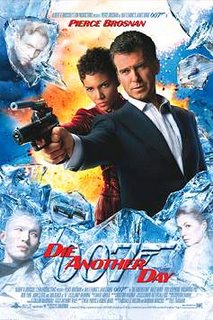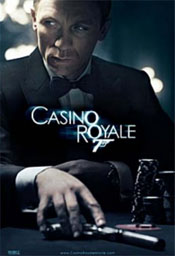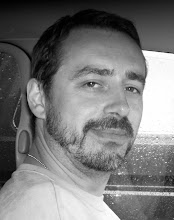The producers and the director are obviously aware that over the past few years the stakes in the action genre have been raised to the stratosphere, mainly on the backs of those little ones and zeros that make up the digital effects that are so common in modern big-budget films. On the other hand, this film is a significant milestone in Bond movie history: it’s the 20th film, and it’s been 40 years since Sean Connery first played the definitive big screen 007 in Dr. No. (Trivia note: the very first actor to play James Bond was American actor Barry Nelson in a television version of Casino Royale.) So the filmmakers probably felt obliged to pay respect to the tradition of the series. As a result, we have one half classic Bond, and one half crowd-pleasing special effects fest. And you can almost identify the exact moment when Die Another Day shifts from one to the other.
The film begins with a wonderfully exciting pre-credits sequence. Bond, superbly played by Pierce Brosnan, poses as an arms dealer in North Korea. Soon, the gig is up, and we’re treated to a traditionally Bondian action sequence featuring hovercraft racing over a minefield. To up the stakes, the mines leap three feet in the air before they explode, and the villains have high-tech guns with exploding bullets and flame throwers. Great stuff, enough to make fans of this kind of thing giddy. Then comes an interesting twist.
For the first time in the films Bond, after being captured, undergoes serious torture. In the Ian Fleming books, Bond was sadistically tortured, but the movies have rarely depicted this. The torture scene is included as a plot element during the title sequence, an inspired idea that, combined with the stunning visuals, makes this perhaps the most memorable titles of any Bond film. After that, the remaining first half of the film was excellent, and classic Bond.
For the second half of the movie, think Moonraker popping CGI steroids. For those not in the know, Moonraker featured a smirking Roger Moore in the most cartoony, silly Bond film of all. Thankfully, Die Another Day never quite sinks to those depths, though a cheesy effects sequence in the Icelandic sea comes close. Brosnan struggles admirably to keep the focus on the character of Bond, but he’s defeated in the end by trendy MTV-style editing and camera work, an overuse of CGI effects, sound that is cranked up way too loud, and just one damn action scene after another.
It is a paradox of action cinema that too much wall-to-wall action actually ends up being boring. You almost slip into sensory overload, and become disengaged with the onscreen action. The best action filmmakers, like James Cameron, understand this and give their films peaks and valleys that allow the audience time to breathe. The final act of Die Another Day piles on so much overcranked action that the climactic undoing of the villain’s plans has little dramatic effect. After the superb first half, the film ends with a whimper.
So, what are we left with? After the near-perfect mix of character, plot, and action in The World is Not Enough, this one seriously overbalances into over-the-top action fantasy. In spite of it all, however, Pierce Brosnan pulls off an excellent performance, hinting at a depth of character even in the most outlandish sections. Serious Bond fans will love the first half and shake their heads at the second. Casual fans, and fans of action cinema in general, may enjoy the whole thing.
My advice to the producers for the next one: ditch the cartoony CGI, keep the balance of plot, character and action, and don’t be afraid to be classically Bondian. These films are too precious to turn into just another video game actioner.
This time around, 007 (Pierce Brosnan) is assigned to protect Elektra King (Sophie Marceau), daughter of an assassinated oil baron, and unravel a complex scheme hatched by terrorist Renard (Robert Carlyle), involving the sabotage of a vast oil pipeline. I won’t say much more about the plot, because one of the joys of this film is figuring out who is doing what, and why.
In his third appearance as James Bond, Pierce Brosnan hits exactly the right note. His Bond is stylish and witty, but coloured with darker shadings that hint at the assassin beneath. In Brosnan’s capable hands, Bond has—surprise!—depth and emotion. He plays the dramatic scenes extremely well, and is adept in the many action scenes. In my book, he has now surpassed Timothy Dalton in the role, who I consider second only to Sean Connery. Will he ever surpass Connery? Of course not, because Connery’s the man, but with this performance, he comes a close second.
Desmond Llewelyn makes what appears to be his last appearance as Q, gadget-master. If so, this is the passing of an era, and Q’s final exit scene is unfortunately unmemorable. Llewelyn, who has been in almost all of the Bond films, deserved more. On the plus side, Q’s replacement, played by John Cleese, looks to be a worthy successor. This is good, as Cleese has signed to do three more Bond films.
Director Michael Apted here helms his first Bond movie, and does a great job. Both Brosnan and the producers hired Apted to emphasize the characters, and he does just that. He handles the dramatic aspects with skill and flair, while still retaining an essential “Bond style.” I have my fingers crossed that the producers will bring Apted back for the next installment. If so, he just may turn out to be the best director that the Bond series has seen, barring possibly Terence Young, who directed three of the best Connery films and set the style of the 007 movies.
Apted and stunt coordinator Vic Armstrong directed the action scenes, and they are as impressive as anything in the Bond films. The traditional “pre-credits” scene features two impressive stunt sequences, the second involving a spectacular boat chase along the Thames. This chase is tremendously exciting, pumped up by David Arnold’s adrenalin-inducing music score. Other action set pieces involve Bond and Elektra being pursued by snowmobiles gliding on parasails, and a deadly buzzsaw contraption suspended from a helicopter, plus the usual assortment of punch-ups, gunfights, and last minute escapes.
But in the final analysis, it’s the plot and characters that elevate this film to the upper echelon of the Bond series. Sure, it follows the Bond Formula (though admittedly adding a few twists), but while some past Bonds have emphasized gadgetry and silliness over plot, this movie redresses the balance. The World is Not Enough is top-notch Bond, showing the 007 formula humming along at its best.










